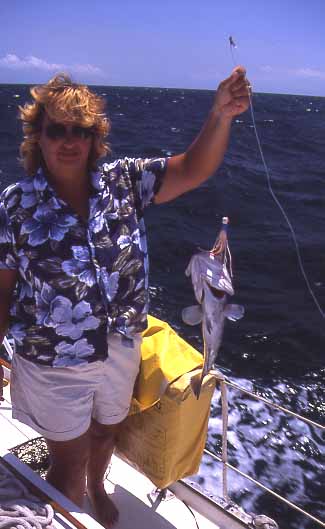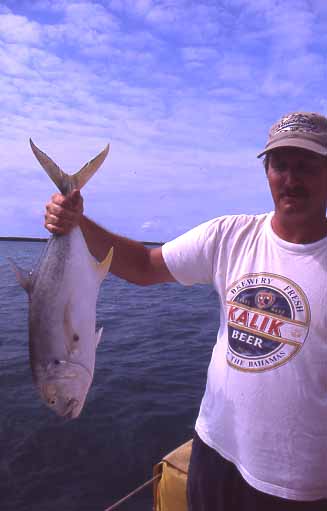
Catching Dinner
By Barbara Theisen
We have a rule of thumb on Out of Bounds when it comes to fishing. We don’t bring aboard fish that are big enough to have an oar jammed down their throat. We didn’t come up with this handy rule of thumb through experience, fortunately. It just seems to make a lot of sense to us. It’s a new rule, but I think we’ll stick with it.
 |
| Barb shows off the grouper she pulled in. |
When we’re sailing, we aren’t actually very active fisherman. We troll a handline off the stern of the boat. A handline is the ultimate in simplicity when it comes to fishing. It’s basically just fishing line attached to a wooden “handle.” This means no expensive rods or reels. It also means less equipment to store.
Here’s how we made our handline. Starting at the all important hook end of
things, we attach a pretty hefty hook or lure/hook combination to about 40 feet
of 100-pound test fishing line. We attach this to 80 feet of ¼” nylon line. At
this point we attach the line to a planer. The planer keeps your lure beneath
the water. The other end of the planer gets attached to an additional 40 feet of
line. This can be adjusted - less line makes the planer (and your lure) stay
shallower and more line will cause the planer (and lure) to go deeper. This line
is then secured to our homemade handle. A rubber snubber (surgical hose) tied
near the end of the line makes a foot and a half to two foot of slack in the
line. This helps to take some of the strain off of the line when the fish
strikes. The line off of the snubber is cleated off. We happen to have a cleat
about eight feet forward of the stern that we use. The handle is a piece of
plywood cut into an “H” and is all that is needed to wind-up the fishing line.
To begin fishing, we toss the hook/lure into the water while we unwind line from
around the handle. When we get to the planer, we hold onto it, while we cleat
off the snubber. Next we must set the planer. By holding about two feet of line
on either side of the planer, we lower the planer and drop it in the water. The
planer should sink down under the surface. This may take a bit of practice, but
is fairly easy to do. We can put out a line on both sides of the boat.
For trolling we usually use an artificial lure. We have a variety of lures in
our tackle box. We really don’t know much about lure selection, but we have
learned a few things. When we are in really clear water, bright colored lures –
pink, orange, yellow - seem to work best. In murky waters, we use silver or
blue. When we’re in an area where we might catch something like a tuna, a
dolphin fish (mahi mahi) or a similar fish, we usually use a squid type lure.
Spoons seem to work well for mackerel. But I’ve heard that if you’re sailing
through an area where there are hungry fish, they’ll strike on just about
anything. Then you can save your lures and simply attach a bit of yarn or some
aluminum foil.
| What the heck did we catch? We haven’t yet identified this weird fish we caught in Belize. We released him so he can scare some other fisherman. |
When our metal lures start to look a bit worn, we give them a fresh sparkle by
applying a coat of gold or silver glitter nail polish. You can buy a bottle for
a buck or two and revive a whole tackle box full of lures. Tom says this is what
happens to the world of fishing when you live aboard with three females.
Once the sails are set and we’ve settled into our routines of the day, I’ll
usually decide to throw the handline out. Then I intensely watch it for five
minutes, sure that we’ll hook a fish any second. Then I lose interest and tend
to check on the line every half hour or so.
 |
| Tom holds up a nice amberjack that we caught on the handline. |
When we hook a fish, the planer pops up to the surface and we know it’s time to
reel the fishing line in. We leave the snubber cleated to the boat, while we
wind the fishing line around the handle and someone readies the net.
The other day we reeled in a plump cero (I simply called it “dinner”). Naturally
we caught it just as we were coming off endless depths, over the wall, and onto
soundings. On the one hand, this is generally a great place to fish, as you’re
almost sure to catch something. On the other hand, catching a fish here tends to
distract you from more important things such as keeping your boat (your home,
your family and all of your processions) off of the reef.
Fortunately, we have a great way to deal with fish that we reel in. We pour a
small shot of booze into their gills. They’re instantly dead (Tom likes to think
they go out happy), with no flopping around throwing fish slime everywhere. It’s
much better than clubbing them and getting fish blood everywhere too. A big,
flopping fish on deck also tends to distract you, so humanely killing the fish
quickly lets you get back to that important chore of navigation. Tom’s tip on
dealing with the fresh catch is to clean it as soon as possible. He says that
the sooner you clean, the better the taste.
So there we were with dinner and we had safely made it inside the reef. I got
out my favorite cookbook, The Cruising Chef Cookbook by Michael Greenwald to
thumb through some fish recipes. This cookbook isn’t just a compilation of great
recipes; it’s actually one of the funniest books I’ve ever read. And it gives
advice on not just cooking, but storing food and all sorts of nautical tips. It
also has some handy advice on fishing. As I’m paging through to the fish
recipes, I come across one of Greenwald’s tips, on “catching sharks.”
I read that “Sharks, even small ones, don’t like being caught and have
difficulty with the concept of being dead. A blow on the top of their head kills
them but does not eliminate the possibility that a “dead” shark won’t suddenly
lunge out and ruin your day. Their incredibly durable nervous system makes them
dangerous for a long time. Jam an oar down their throat so they can’t bite you.”
| A Rio Dulce perch called mojarra is ready for the frying pan. |
That’s when I decided that if a fish was big enough to have an oar jammed down
their throat, maybe we shouldn’t bring it aboard in the first place. Dinner, by
the way, was delish!
Barbara Theisen, her husband, Tom, and their daughters, Kate and Kenna, moved
aboard their 41’ Gulfstar sailboat, Out of Bounds, thirteen years ago. Tom has
been catching dinner for his family during these years and has fed them well
with fresh fish, lobster, conch, blue crabs and shrimp. For more information on
living the cruising life, visit the Theisen’s Website at www.TheCruisingLife.com.